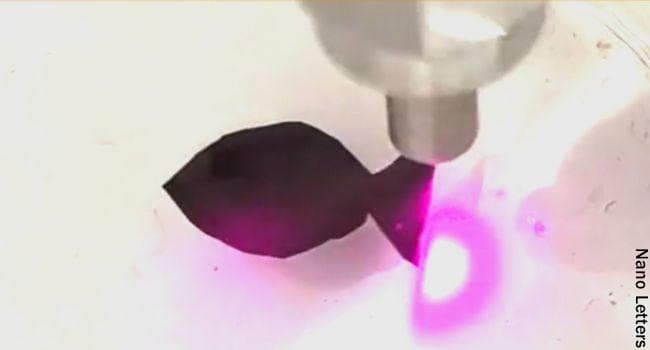June 27, 2022 – You will have possible ingested microplastic at this time. They’re within the air we breathe, the water we drink, and most of the meals we eat, and scientists say human publicity is nearly unattainable to keep away from at this level.
Assist could also be on the best way within the type of a newly created “tender robotics” fish designed to seize up all this polymer air pollution, no less than from the ocean. At 13 millimeters (a few half-inch) lengthy, the robo-fish is designed to resemble the true factor. Together with its plastic-luring potential, it’s self-powered and might navigate complicated aquatic environments with the assistance of near-infrared laser know-how (NIR).
Its physique is stretchy, versatile, and nimble, similar to the true deal. By pointing a NIR laser at its tail, the scientists can coax the fish robotic’s fins to vary form and propel its minnow-like physique in a swim-like movement.
“Microplastic air pollution in water is a serious drawback confronted by human beings,” the Chinese language scientists say of their Nano Lettersanalysis paper, “[They] can soak up heavy metals, poisonous natural contaminants, and pathogens.”
If broken whereas on the transfer, no drawback. The robo-fish can restore itself with 89% effectivity and proceed its relentless pursuit of plastics. To check the mechanical creature’s self-healing abilities, the researchers sliced into the robotic’s masking and let it get well at room temperature. The bot was restored to its unique state, with scarring on the injury website nearly disappearing, because of layers of nanosheet impressed by the pearly deposit on the within of many mussels and clams generally known as nacre or mother-of-pearl, the researchers say.
“Our nacre-like gradient nanostructure imparts not solely power and toughness, but in addition performance to the fabric,” the scientists famous.
Analysis has discovered there are round 24.4 trillion items of microscopic plastic particles within the higher oceans, and that is prone to be an underestimate, new analysis finds. Lately, research have detected nano plastic particles within the lungs and bloodstream of people. In reality, microscopic bits of plastic have most definitely taken up residence in the entire main filtering organs, post-mortem research on cadavers counsel. Though the danger of the miniscule pollution’ presence within the physique is unclear, scientists are exploring what it means for our well being.
Utilizing nature as their muse, the robo-fish researchers say they hope the sturdy aquatic imposters will sometime assist take away microplastics from the atmosphere.
“I believe nanotechnology holds nice promise for hint adsorption, assortment, and detection of pollution,” lead examine writer Yuyan Wang informed The Guardian. “It’s of nice significance to develop a robotic to precisely accumulate and pattern detrimental microplastic pollution from the aquatic atmosphere.”



Recent Comments